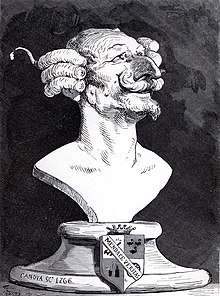
Back البارون فون مونشهاوزن Arabic البارون فون مونشهاوزن ARZ Baron Münxhauzen AZ Барон Мюнхаузен Bulgarian Baron Münchausen BR Baró de Münchhausen Catalan Karl Friedrich Hieronymus von Münchhausen Czech Münchhausen CY Baron von Münchhausen Danish Hieronymus Carl Friedrich von Münchhausen German
| Baron Munchausen | |
|---|---|
 Gustave Doré's portrait of Baron Munchausen | |
| First appearance | Baron Munchausen's Narrative of his Marvellous Travels and Campaigns in Russia (1785) |
| Created by | Rudolf Erich Raspe |
| Portrayed by |
|
| Voiced by |
|
| Based on | Hieronymus Karl Friedrich von Münchhausen (1720–1797) |
| In-universe information | |
| Nickname | Lügenbaron ("Baron of Lies") |
| Title | Baron |
| Nationality | German |
Baron Munchausen (/ˈmʌntʃaʊzən, ˈmʊntʃ-/;[1][2][a] German: [ˈmʏnçˌhaʊzn̩]) is a fictional German nobleman created by the German writer Rudolf Erich Raspe in his 1785 book Baron Munchausen's Narrative of his Marvellous Travels and Campaigns in Russia. The character is loosely based on baron Hieronymus Karl Friedrich Freiherr von Münchhausen.
Born in Bodenwerder, Hanover, the real-life Münchhausen fought for the Russian Empire during the Russo-Turkish War of 1735–1739. After retiring in 1760, he became a minor celebrity within German aristocratic circles for telling outrageous tall tales based on his military career. After hearing some of Münchhausen's stories, Raspe adapted them anonymously into literary form, first in German as ephemeral magazine pieces and then in English as the 1785 book, which was first published in Oxford by a bookseller named Smith. The book was soon translated into other European languages, including a German version expanded by the poet Gottfried August Bürger. The real-life Münchhausen was deeply upset at the development of a fictional character bearing his name, and threatened legal proceedings against the book's publisher. Perhaps fearing a libel suit, Raspe never acknowledged his authorship of the work, which was only established posthumously.
The fictional Baron's exploits, narrated in the first person, focus on his impossible achievements as a sportsman, soldier, and traveller; for instance: riding on a cannonball, fighting a forty-foot crocodile, and travelling to the Moon. Intentionally comedic, the stories play on the absurdity and inconsistency of Munchausen's claims, and contain an undercurrent of social satire. The earliest illustrations of the character, perhaps created by Raspe himself, depict Munchausen as slim and youthful, although later illustrators have depicted him as an older man, and have added the sharply beaked nose and twirled moustache that have become part of the character's definitive visual representation. Raspe's book was a major international success, becoming the core text for numerous English, continental European, and American editions that were expanded and rewritten by other writers. The book in its various revised forms remained widely read throughout the 19th century, especially in editions for young readers.
Versions of the fictional Baron have appeared on stage, screen, radio, and television, as well as in other literary works. Though the Baron Munchausen stories are no longer well known in many English-speaking countries, they are still popular in continental Europe. The character has inspired numerous memorials and museums, and several medical conditions and other concepts are named after him.
- ^ Cambridge University Press 2015.
- ^ "Munchausen, Baron", Lexico UK English Dictionary, Oxford University Press[dead link]
- ^ Olry 2002, p. 56.
- ^ Fisher 2006, p. 257.
Cite error: There are <ref group=lower-alpha> tags or {{efn}} templates on this page, but the references will not show without a {{reflist|group=lower-alpha}} template or {{notelist}} template (see the help page).